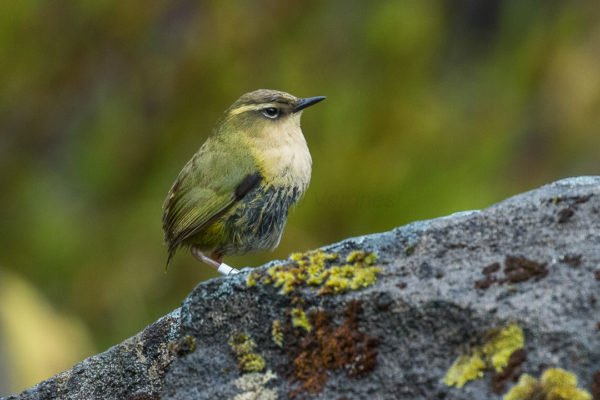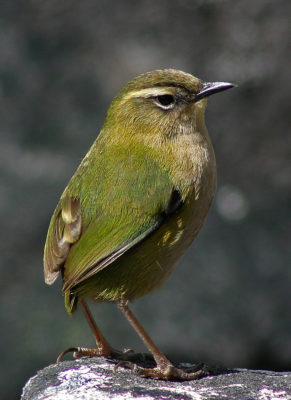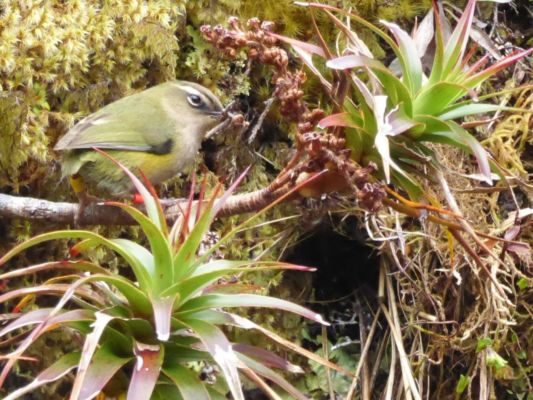In research just published in international ornithology journal Ibis, Department of Conservation scientist Kerry Anne Weston, Colin O’Donnell, Paul van Dam-Bates and Joanne Monks investigated the impact of introduced mammalian predators in our little-studied alpine region.
Their study revealed that stoats and house mice are the 2 introduced predators having the most impact on New Zealand rockwren – a tiny alpine bird species – and that predator control can lead to a significant, measurable improvement in nesting success.

“The New Zealand rockwren (Xenicus gilviventris), is a small (14-20 g) alpine specialist, only found above the climatic tree line. Juveniles establish territories and form breeding pairs within the same season that they fledge and commence nesting the following spring. The rockwren is one of only two remaining members of an ancient endemic lineage of primarily ground-dwelling passerines.”
In the past it was thought alpine species such as rockwrens were relatively safe from predators compared to their forest-living relatives, protected by the harsh conditions of their alpine environment. But recent research has revealed that invasive predators are widespread in our alpine regions too.
“The objective of this study was to investigate the influence of invasive predators on the breeding ecology of rockwrens by:
1. identifying predators visiting rockwren nests and their predation rates; and
2. investigating whether kill-trapping of invasive mammalian predators increases rockwrens’ breeding success.”
Rockwren nests were monitored over 5 breeding seasons, from 2012-2017.
“Breeding success of rockwrens was monitored in three study areas. The Haast Range study site in Mount Aspiring National Park is primarily snow tussock Chionochloa spp. grassland inter-dispersed with patches of subalpine scrub, rocky bluff systems, scree slopes and boulder fields. The Homer-Gertrude Cirque site in northern Fiordland National Park is comprised of extensive boulder fields and prostrate herbs, with large areas of subalpine scrub and snow tussock. The Lake Roe site in southern Fiordland National Park encompasses extensive snow tussock grasslands inter-dispersed with patches of subalpine scrub, rocky bluff systems, scree slopes and boulder fields.”
The nesting birds were closely – but discretely – monitored.

“Nest activity (incubating, feeding nestlings, fledged, failed) was recorded during visits at least once every four days using binoculars from a distance to minimise disturbance. For nests that could be accessed safely, the number of eggs and nestlings were recorded at each visit. Continuous 24 hour recording and motion-triggered camera set-ups were also used at a subset of nests (38 of 146 nests, 26%) to monitor nesting behaviours and outcomes, and to identify predators. Cameras were not set up until eggs had been laid to reduce the risk of nest abandonment. A nest was considered successful if at least one chick fledged.”
Predator control was ground-based, with trapping was carried out at 2 of the 3 research sites by local volunteer groups.
“Predator trapping occurred in the Homer-Gertrude Cirque and Haast Range after one and two seasons of non-treatment, respectively. The Lake Roe site was not trapped. Traps used were DOC 150 and DOC 200 models, which are designed to target mustelids and rats humanely. At Homer-Gertrude Cirque, predator trapping was established in the 2013 – 2014 season by local conservation volunteer groups. The network consisted of 37 kill traps (c. 200 m apart and covering c. 200 ha of habitat). In the Haast Range, a predator trapping network was established in September 2015, consisting of 89 kill traps spaced 200 m apart and covering c. 400 ha of habitat. Traps in both areas were checked and re-baited monthly with hen’s eggs, fresh rabbit or dehydrated rabbit, between October – May each year.”
Rockwrens nest in shallow cavities which gives them some protection from harsh alpine weather, but also makes them particularly vulnerable to predation.
“Nesting began in early October (austral spring), with the last nests fledging by mid-February. In total, 146 nests were located, all above the treeline. An almost completely enclosed, spherical or elliptical shaped nest was built inside an excavated cavity, with a single entrance hole at or towards one end. Nest building was conducted by both sexes. Nests were most commonly built within cracks, or vegetated ledges on rock faces and large free-standing boulders. Nests were distributed along an elevational gradient of approximately 500 metres.”
Both parents incubate eggs and feed and brood the young during the day, but only the female incubates eggs and broods nestlings at night.
“The contents of 31 nests were accessible during incubation across all sites. Mean clutch size was 3.97 (range 2 – 5 eggs). The mean number of eggs hatched per nest was 1.81 (range 0 – 4).”
Raising nestlings is incredibly demanding for both parents.
“Time spent brooding young decreased as the nestlings grew and demands for food increased. During the final week of the nestling phase, large food items were being delivered to the nest every 3 – 4 minutes during daylight hours.”

As nestlings grow they become more and more conspicuous to predators.
“Nestlings became increasingly noisy and could be seen at the nest entrance in the days prior to fledging. Broods of nestlings fledged synchronously, calling frequently. Overall, 0.97 chicks (range 0 – 4) fledged per nest. Re-nesting of the same pair was observed both after failed nesting attempts (14 of 140 nests, 10%) and after successful nesting attempts (7 of 140 nests, 5%). One pair commenced building of their second nest whilst still feeding nestlings in their first nest.”
Less than half of nesting pairs succeeded in fledging their chicks.
“Of the 146 nests monitored, the outcome (success or fail) was confirmed for 140 nests. In total, 46% of nests were successful. Predation was the most common cause of nest failure, with evidence of predation recorded at 48% of failed nests. Evidence included camera footage, damage to nests, the presence of remains, bite/gnaw marks, faeces and fur. Most confirmed predation events were by mustelids (17 of 36 nests; 47%) and to a lesser extent, house mice (4 of 36 nests, 11%).”
Predator control did, however, make a difference.
“Mustelid predation was the primary cause of nest failure when predator control was not in place; in contrast, no mustelid predation events were confirmed when predator control was established. Stoats were the only mustelids identified to species and were captured on cameras at all three sites (n = 15 nests). They characteristically removed the entire nest contents (eggs, nestlings and brooding adults) and left nest entrances enlarged.”
Mice were also significant predators.
“Mice gnawed and cracked open eggs in the nest, leaving behind broken egg shell and preyed upon nestlings, leaving gnaw marks and fatal wounds. Rat (species unknown) faeces were found in one nest which also contained two dead chicks and part of a head. Possum gnaw marks were identified on the eggs from one nest.”
Where predators were controlled, weather was a likely factor in nest failures that still occurred.
“Nest abandonments were the most common known cause of nest failure when predator control was in place. At least three of these abandonments appear to have been weather-related, occurring during periods of heavy snow. On one occasion, during a snow storm which lasted several days, a nest became completely buried by snow. The birds continued to burrow through the snow to the nest, though they subsequently abandoned its three chicks nearing fledging. The cause of failure was unknown for 26 nests.”
Stoat numbers don’t need to be high for predation to have a significantly detrimental effect.
“Thirty-three stoats were trapped within the treatment areas during the study period (Haast Range = 16; Homer-Gertrude Cirque = 17). Stoat captures were generally low, though highest during the rockwrens’ chick brooding phase. Ten rats and one house mouse were also caught during the study period. The proportion of chicks that fledged per nest was significantly higher when predators were controlled (0.69) compared with no predator control (0.14). Only one of 13 nests fledged chicks when there was no predator trapping.”
“Although rockwrens appeared well-adapted to breeding in the extreme alpine conditions, the primary cause of nest failures was predation by invasive mammals. Breeding success of rockwrens was improved substantially by predator trapping at both sites where it was implemented, even with low numbers of predators being trapped across the landscape. This indicates that relatively low numbers of predators can have a significant impact on the breeding success of sensitive alpine species.’
Masting of alpine tussocks may have an effect on mouse and hence stoat numbers in the alpine environment in a similar way to how masting events effect predation in lower altitude forests.
“There is some evidence that house mice reach high densities in alpine habitats, particularly in years when snow tussocks are mast seeding. It is likely that stoat populations also increase following mast years in response to the increased abundance of mice above the treeline, though evidence of this relationship in alpine ecosystems is currently lacking.”
Rats appear to be less of a problem in the alpine zone – at least for the time being.
“Whilst rats are among the most common predators of New Zealand’s forest birds, rat predation was only recorded once at a rockwren’s nest. Rats are relatively uncommon at higher elevations in New Zealand, which is likely attributed to a climatic preference for warmer, lower elevation habitats. However, global warming may result in range shifts in rats to higher elevations.”
Given the impact that predators appear to be having in our alpine regions, there is a strong case for carrying out more predator control in our mountains – but how? As the researchers conclude – new methods are urgently needed.
“Predator control involved only ground-based trapping, targeting mustelids and rats. The logistics of trapping at landscape-scale across alpine habitats are challenging. Novel predator control techniques that can safely be applied at scale above the treeline are urgently required.”
This research paper is published in Ibis, where only the abstract is freely available to non-subscribers.
Control of invasive predators improves breeding success of an endangered alpine passerine (2018)

